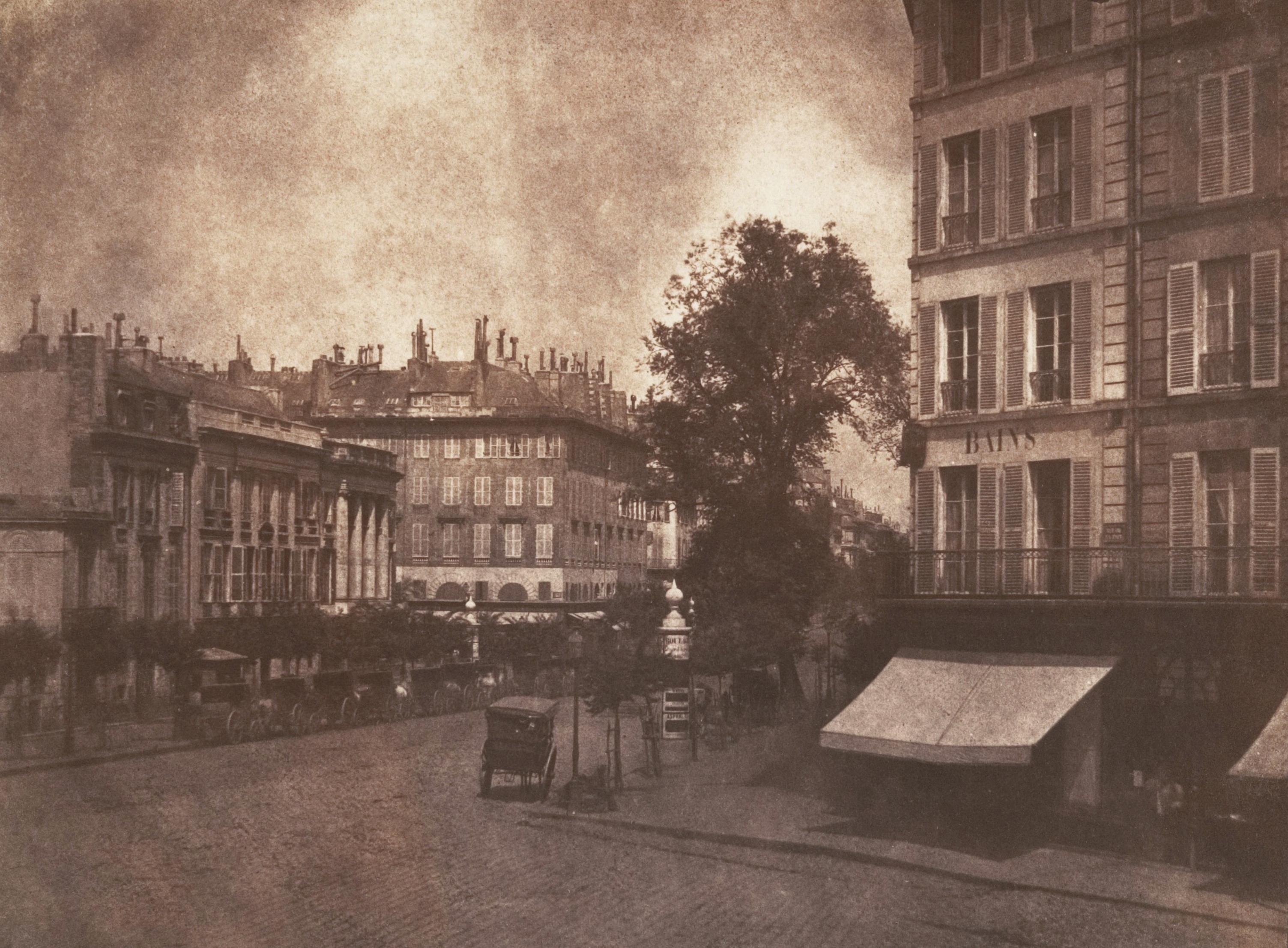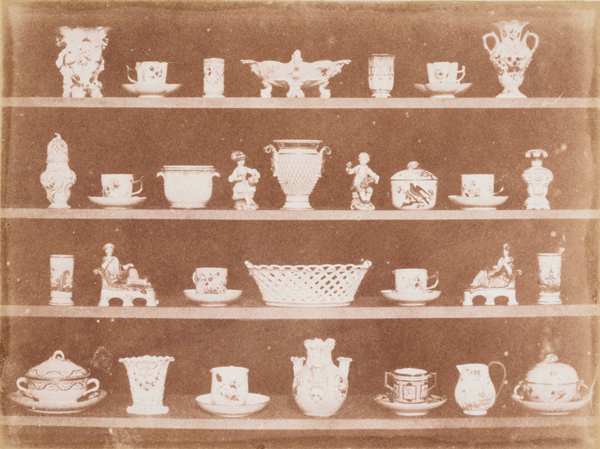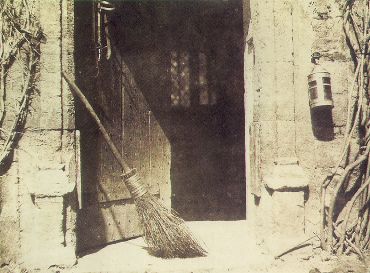The Pencil Of Nature on:
[Wikipedia]
[Google]
[Amazon]
 ''The Pencil of Nature'' is a book by
''The Pencil of Nature'' is a book by





 The 24 plates in the book were carefully selected to demonstrate a wide variety of potential applications for photography. They include a variety of architectural studies, scenes, still-lifes, and closeups, as well as facsimiles of prints, sketches, and text. Due to the long exposure times involved, however, Talbot included only one portrait, The Ladder (Plate XIV). Talbot also sought to demonstrate photography's potential as a new artistic medium with images like The Open Door (Plate VI).
The complete list of plates is as follows:
*Part 1
**I. Part of
The 24 plates in the book were carefully selected to demonstrate a wide variety of potential applications for photography. They include a variety of architectural studies, scenes, still-lifes, and closeups, as well as facsimiles of prints, sketches, and text. Due to the long exposure times involved, however, Talbot included only one portrait, The Ladder (Plate XIV). Talbot also sought to demonstrate photography's potential as a new artistic medium with images like The Open Door (Plate VI).
The complete list of plates is as follows:
*Part 1
**I. Part of
 ''The Pencil of Nature'' is a book by
''The Pencil of Nature'' is a book by William Henry Fox Talbot
William Henry Fox Talbot FRS FRSE Royal Astronomical Society, FRAS (; 11 February 180017 September 1877) was an English scientist, inventor, and photography pioneer who invented the Salt print, salted paper and calotype processes, precursors t ...
which was the first commercially published book to be illustrated with photographs. Published by Longman, Brown, Green & Longmans in six fascicles between 1844 and 1846, the book detailed Talbot's development of the calotype photographic process and included 24 calotype prints, each one pasted in by hand, illustrating some of the possible applications of the new technology. It is regarded as an important and influential work in the history of photography
The history of photography began in remote antiquity with the discovery of two critical principles: camera obscura image projection and the observation that some substances are visibly altered by exposure to light. There are no artifacts or de ...
and was described by the Metropolitan Museum of Art
The Metropolitan Museum of Art of New York City, colloquially "the Met", is the largest art museum in the Americas. Its permanent collection contains over two million works, divided among 17 curatorial departments. The main building at 1000 ...
as "a milestone in the art of the book greater than any since Gutenberg's invention of moveable type."
At the time ''The Pencil of Nature'' was published, photography was still an unfamiliar concept for most people—the ''Athenaeum
Athenaeum may refer to:
Books and periodicals
* ''Athenaeum'' (German magazine), a journal of German Romanticism, established 1798
* ''Athenaeum'' (British magazine), a weekly London literary magazine 1828–1921
* ''The Athenaeum'' (Acadia U ...
'' magazine described Talbot's work as "modern necromancy
Necromancy () is the practice of magic or black magic involving communication with the dead by summoning their spirits as apparitions or visions, or by resurrection for the purpose of divination; imparting the means to foretell future even ...
"—and the book was the first opportunity for the general public to see what photographs looked like. To avoid any confusion, Talbot inserted the following notice into the book:
The cover page for ''The Pencil of Nature'' clashed designs, which was characteristic of the Victorian era
In the history of the United Kingdom and the British Empire, the Victorian era was the period of Queen Victoria's reign, from 20 June 1837 until her death on 22 January 1901. The era followed the Georgian period and preceded the Edwardia ...
, with styles inspired by baroque, Celtic, and medieval
In the history of Europe, the Middle Ages or medieval period lasted approximately from the late 5th to the late 15th centuries, similar to the post-classical period of global history. It began with the fall of the Western Roman Empire ...
elements.Meggs, Philip B., Purvis, Alston W. "Graphic Design and the Industrial Revolution" ''History of Graphic Design''. Hoboken, N.J: Wiley, 2006. p.152-153. Its symmetrical design, letterforms, and intricate carpet page
A carpet page is a full page in an illuminated manuscript containing intricate, non-figurative, patterned designs.Moss, 57 They are a characteristic feature of Insular manuscripts, and typically placed at the beginning of a Gospel Book. Carpet p ...
s are similar to and a pastiche of the Book of Kells.
''The Pencil of Nature'' was published and sold one section at a time, without any binding (as with many books of the time, purchasers were expected to have it bound themselves once all the installments had been released). Talbot planned a large number of installments; however, the book was not a commercial success and he was forced to terminate the project after completing only six.
Photographs





 The 24 plates in the book were carefully selected to demonstrate a wide variety of potential applications for photography. They include a variety of architectural studies, scenes, still-lifes, and closeups, as well as facsimiles of prints, sketches, and text. Due to the long exposure times involved, however, Talbot included only one portrait, The Ladder (Plate XIV). Talbot also sought to demonstrate photography's potential as a new artistic medium with images like The Open Door (Plate VI).
The complete list of plates is as follows:
*Part 1
**I. Part of
The 24 plates in the book were carefully selected to demonstrate a wide variety of potential applications for photography. They include a variety of architectural studies, scenes, still-lifes, and closeups, as well as facsimiles of prints, sketches, and text. Due to the long exposure times involved, however, Talbot included only one portrait, The Ladder (Plate XIV). Talbot also sought to demonstrate photography's potential as a new artistic medium with images like The Open Door (Plate VI).
The complete list of plates is as follows:
*Part 1
**I. Part of Queen's College, Oxford
The Queen's College is a constituent college of the University of Oxford, England. The college was founded in 1341 by Robert de Eglesfield in honour of Philippa of Hainault. It is distinguished by its predominantly neoclassical architecture, ...
**II. View of the Boulevard
A boulevard is a type of broad avenue planted with rows of trees, or in parts of North America, any urban highway.
Boulevards were originally circumferential roads following the line of former city walls.
In American usage, boulevards may ...
s at Paris
**III. Articles of China
**IV. Articles of Glass
Glass is a non-crystalline, often transparent, amorphous solid that has widespread practical, technological, and decorative use in, for example, window panes, tableware, and optics. Glass is most often formed by rapid cooling ( quenching ...
**V. Bust
Bust commonly refers to:
* A woman's breasts
* Bust (sculpture), of head and shoulders
* An arrest
Bust may also refer to:
Places
* Bust, Bas-Rhin, a city in France
*Lashkargah, Afghanistan, known as Bust historically
Media
* ''Bust'' (magazin ...
of Patroclus
*Part 2
**VI. The Open Door
**VII. Leaf of a Plant
**VIII. A Scene in a Library
**IX. Fac-simile of an Old Printed Page
**X. The Haystack
**XI. Copy of a Lithographic Print
**XII. The Bridge of Orléans
Orléans (;"Orleans"
(US) and Lacock Abbey Lacock Abbey in the village of Lacock, Wiltshire, England, was founded in the early 13th century by Ela, Countess of Salisbury, as a nunnery of the Augustinian order. The abbey remained a nunnery until the suppression of Roman Catholic inst ...
in (US) and Lacock Abbey Lacock Abbey in the village of Lacock, Wiltshire, England, was founded in the early 13th century by Ela, Countess of Salisbury, as a nunnery of the Augustinian order. The abbey remained a nunnery until the suppression of Roman Catholic inst ...
Wiltshire
Wiltshire (; abbreviated Wilts) is a historic and ceremonial county in South West England with an area of . It is landlocked and borders the counties of Dorset to the southwest, Somerset to the west, Hampshire to the southeast, Gloucestershire ...
*Part 4
**XVI. Cloisters
A cloister (from Latin ''claustrum'', "enclosure") is a covered walk, open gallery, or open arcade running along the walls of buildings and forming a quadrangle or garth. The attachment of a cloister to a cathedral or church, commonly against ...
of Lacock Abbey
**XVII. Bust of Patroclus
**XVIII. Gate of Christchurch
Christchurch ( ; mi, Ōtautahi) is the largest city in the South Island of New Zealand and the seat of the Canterbury Region. Christchurch lies on the South Island's east coast, just north of Banks Peninsula on Pegasus Bay. The Avon Rive ...
*Part 5
**XIX. The Tower of Lacock Abbey
**XX. Lace
Lace is a delicate fabric made of yarn or thread in an open weblike pattern, made by machine or by hand. Generally, lace is divided into two main categories, needlelace and bobbin lace, although there are other types of lace, such as knitted o ...
**XXI. The Martyrs' Monument
*Part 6
**XXII. Westminster Abbey
Westminster Abbey, formally titled the Collegiate Church of Saint Peter at Westminster, is an historic, mainly Gothic church in the City of Westminster, London, England, just to the west of the Palace of Westminster. It is one of the Unite ...
**XXIII. Hagar in the Desert
**XXIV. A Fruit Piece
Text
Each plate is accompanied by a short text which describes the scene and the photographic processes involved in obtaining it. Talbot emphasized the practical implications of his images (for instance, "The whole cabinet of a Virtuoso and collector of old China might be depicted on paper in little more time than it would take him to make a written inventory describing it in the usual way."), but he also recognized their artistic value ("The chief object of the present work is to place on record some of the early beginnings of a new art, before the period, which we trust is approaching, of its being brought to maturity by the aid of British talent.") Due to the novelty of the subject, Talbot needed to point out some things that seem obvious today; for instance, "Groups of figures take no longer time to obtain than single figures would require, since the Camera depicts them all at once, however numerous they may be." He also speculated about such questions as (among others) whether photographs would stand up as evidence incourt
A court is any person or institution, often as a government institution, with the authority to adjudicate legal disputes between parties and carry out the administration of justice in civil, criminal, and administrative matters in acco ...
and whether a camera could be made to record ultraviolet
Ultraviolet (UV) is a form of electromagnetic radiation with wavelength from 10 nm (with a corresponding frequency around 30 PHz) to 400 nm (750 THz), shorter than that of visible light, but longer than X-rays. UV radiation ...
light.
At the beginning of the book, Talbot included an incomplete history of his development of the calotype, titled "Brief Historical Sketch of the Invention of the Art." The history ends rather abruptly, and though Talbot expressed his intention to complete it at a later date, he never did.
Editions
About 40 "substantially complete" copies of the original 1844-1846 edition still exist. At least two facsimile editions have been issued: * New York: Da Capo Press, 1969. * New York: Hans P. Kraus, Jr., 1989. * Bath: Monmouth Calotype 1989External links
References
{{DEFAULTSORT:Pencil of Nature, The Photographic collections and books Photography in the United Kingdom 1844 books 1846 books Unfinished books